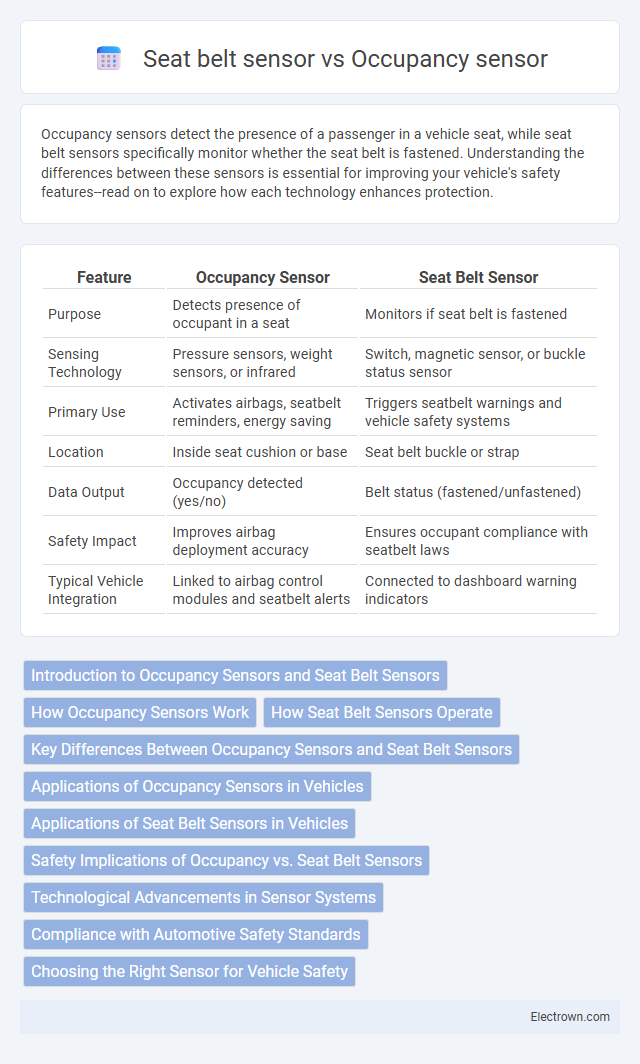Occupancy sensors detect the presence of a passenger in a vehicle seat, while seat belt sensors specifically monitor whether the seat belt is fastened. Understanding the differences between these sensors is essential for improving your vehicle's safety features--read on to explore how each technology enhances protection.
Table of Comparison
| Feature | Occupancy Sensor | Seat Belt Sensor |
|---|---|---|
| Purpose | Detects presence of occupant in a seat | Monitors if seat belt is fastened |
| Sensing Technology | Pressure sensors, weight sensors, or infrared | Switch, magnetic sensor, or buckle status sensor |
| Primary Use | Activates airbags, seatbelt reminders, energy saving | Triggers seatbelt warnings and vehicle safety systems |
| Location | Inside seat cushion or base | Seat belt buckle or strap |
| Data Output | Occupancy detected (yes/no) | Belt status (fastened/unfastened) |
| Safety Impact | Improves airbag deployment accuracy | Ensures occupant compliance with seatbelt laws |
| Typical Vehicle Integration | Linked to airbag control modules and seatbelt alerts | Connected to dashboard warning indicators |
Introduction to Occupancy Sensors and Seat Belt Sensors
Occupancy sensors detect the presence of passengers in a vehicle seat by monitoring weight or infrared signals, ensuring safety systems like airbags deploy appropriately. Seat belt sensors track whether seat belts are fastened, sending alerts to encourage compliance and improve occupant protection. Understanding these sensors helps you enhance vehicle safety by ensuring both occupancy detection and seat belt usage are effectively monitored.
How Occupancy Sensors Work
Occupancy sensors detect the presence of a passenger by using pressure-sensitive mats or infrared technology embedded in the car seat, triggering the airbag system and seat belt reminders accordingly. These sensors integrate with vehicle safety systems to assess seat occupancy, ensuring airbags deploy only when necessary, enhancing passenger protection. Unlike seat belt sensors that monitor belt usage, occupancy sensors primarily focus on detecting if a seat is occupied, optimizing safety feature activation.
How Seat Belt Sensors Operate
Seat belt sensors operate by detecting the presence and tension of the seat belt latch through electrical circuits integrated within the buckle mechanism. When the seat belt is securely fastened, the sensor completes the circuit, signaling the vehicle's safety system to deactivate warning alarms or airbag interlocks. These sensors provide real-time data on seat belt engagement, enhancing occupant safety by ensuring compliance with seat belt usage requirements.
Key Differences Between Occupancy Sensors and Seat Belt Sensors
Occupancy sensors detect the presence of a passenger in a vehicle seat by measuring weight or infrared signals, while seat belt sensors specifically monitor whether the seat belt is fastened. Occupancy sensors enhance airbag deployment decisions and optimize safety system responses, whereas seat belt sensors primarily trigger warning alerts and ensure compliance with safety regulations. The key difference lies in occupancy sensors assessing presence and weight data, whereas seat belt sensors focus on verifying seat belt engagement status.
Applications of Occupancy Sensors in Vehicles
Occupancy sensors in vehicles detect the presence of passengers to optimize airbag deployment and enhance safety systems, reducing the risk of injury during collisions. These sensors also contribute to energy efficiency by managing climate control based on seat occupancy, ensuring comfort without unnecessary power consumption. Furthermore, occupancy sensors assist in alerting drivers to unbuckled passengers and help in child seat detection for added protection.
Applications of Seat Belt Sensors in Vehicles
Seat belt sensors in vehicles play a crucial role in enhancing passenger safety by monitoring seat belt usage and triggering warning signals or disabling certain functions if the seat belt is not fastened. These sensors are integrated with airbag systems to ensure airbags only deploy when the seat belt is engaged, reducing injury risks during collisions. Your vehicle's seat belt sensor also assists in compliance with safety regulations and can be linked to seat occupancy sensors for more accurate monitoring of passenger presence.
Safety Implications of Occupancy vs. Seat Belt Sensors
Occupancy sensors detect the presence of a passenger to activate airbags, while seat belt sensors monitor whether the occupant is securely restrained, directly impacting the deployment and effectiveness of safety systems. Occupancy sensors alone may trigger airbags regardless of seat belt usage, potentially increasing injury risk during collisions, whereas seat belt sensors enhance safety by ensuring airbags deploy only when occupants are properly buckled. Integrating both sensors optimizes vehicle safety by balancing airbag deployment with occupant restraint status, reducing the likelihood of injury in accidents.
Technological Advancements in Sensor Systems
Occupancy sensors utilize advanced infrared, ultrasonic, and weight detection technologies to accurately identify the presence and number of passengers in a vehicle, enhancing safety and energy efficiency. Seat belt sensors integrate pressure-sensitive and smart buckle technologies to detect belt engagement, enabling real-time alerts and improved crash response systems. Your vehicle benefits from the integration of these evolving sensor systems, offering heightened protection through precise monitoring and adaptive safety features.
Compliance with Automotive Safety Standards
Occupancy sensors and seat belt sensors play crucial roles in ensuring compliance with automotive safety standards such as FMVSS 208 and EURO NCAP regulations. Occupancy sensors detect the presence of a passenger to enable or disable airbag deployment, enhancing crash protection, while seat belt sensors ensure Your seat belt is fastened to meet mandatory safety requirements and trigger warning systems. Both sensors work together to improve vehicle safety by adhering to prescribed standards and mitigating injury risks during collisions.
Choosing the Right Sensor for Vehicle Safety
Occupancy sensors detect the presence of a passenger by monitoring weight or infrared signals, preventing airbags from deploying unnecessarily, while seat belt sensors monitor whether the belt is fastened, ensuring compliance with safety protocols. Choosing the right sensor for your vehicle safety system involves understanding that occupancy sensors offer protection tailored to passenger presence, reducing false airbag deployment, whereas seat belt sensors emphasize restraint system engagement and enforcement. Integrating both sensors can optimize safety by combining passenger detection with seat belt usage monitoring.
Occupancy sensor vs Seat belt sensor Infographic

 electrown.com
electrown.com